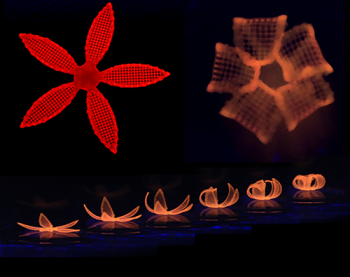Jan 27 2016
A group of scientists from the Harvard John A. Paulson School of Engineering and Applied Sciences and the Wyss Institute for Biologically Inspired Engineering at Harvard University have developed a breakthrough 4D printing method, using time as fourth dimension. The group were inspired by plants and other natural structures, which react to environmental stimuli and change their form accordingly. The scientists have developed 4D printed hydrogel composite structures that change their form when immersed in water.
 This series of images shows the transformation of a 4D-printed hydrogel composite structure after its submersion in water. Credit: Wyss Institute at Harvard University
This series of images shows the transformation of a 4D-printed hydrogel composite structure after its submersion in water. Credit: Wyss Institute at Harvard University
"This work represents an elegant advance in programmable materials assembly, made possible by a multidisciplinary approach. We have now gone beyond integrating form and function to create transformable architectures." said Jennifer Lewis, Sc.D., senior author on the new study.
Lewis is a Core Faculty member at the Wyss Institute for Biologically Inspired Engineering at Harvard University and the Hansjörg Wyss Professor of Biologically Inspired Engineering at the Harvard John A. Paulson School of Engineering and Applied Science (SEAS). L. Mahadevan, Ph.D., a Wyss Core Faculty member as well as the Lola England de Valpine Professor of Applied Mathematics, Professor of Organismic and Evolutionary Biology, and Professor of Physics at Harvard University and Harvard SEAS, is a co-author on the study. Their team also includes co-author, Ralph Nuzzo, Ph.D., the G.L. Clark Professor of Chemistry at the University of Illinois at Urbana-Champaign.
Plants and flower have microstructures and tissue compositions that lead to morphologies, which change based on their environments. The 4D-printed hydrogel composites, developed by Lewis and her team of scientists, have been programmed to contain precise and accurate swelling behaviors. These composites have been developed taking into consideration the wide range of shapes mimicked by plant organs, such as flowers, leaves, and tendrils, while responding to environmental stimuli such as temperature and/or humidity. The hydrogel composites are made up of cellulose fibrils obtained from wood, and are similar the microstructures that help to produce changes in the shape of plants.
4D Printing: Shapeshifting Architectures
This video portrays the microscale printing process and transformation of a 4D-printed, orchid-shaped hydrogel composite structure. Credit: Wyss Institute at Harvard University
The research was reported in Nature Materials. The study’s co-lead authors include A. Sydney Gladman, who is a graduate research assistant advised by Lewis and specializing in the printing of polymers and composites at the Wyss Institute and SEAS, and Elisabetta Matsumoto, Ph.D., who is a postdoctoral fellow at the Wyss and SEAS advised by Mahadevan and specializing in condensed matter and material physics.
Cellulose fibrils are arranged during the printing process and this leads to encoding of the hydrogel composite ink with anisotropic swelling and stiffness, which can be molded to produce different complex shapes. Different directional properties that can be controlled and predicted are developed because of the cellulose fibrils’ anisotropic nature. When hydrogel-cellulose fibril ink is immersed in water, it goes through a variety of swelling changes orthogonal to and along the printing path. The team developed a proprietary mathematical model that helps to predict how a 4D object to obtain the prescribed transformable shapes. The new method incorporated with this mathematical model could be used for a number of applications, including tissue engineering, soft electronics, smart textiles, and biomedical devices.
Using one composite ink printed in a single step, we can achieve shape-changing hydrogel geometries containing more complexity than any other technique, and we can do so simply by modifying the print path. What’s more, we can interchange different materials to tune for properties such as conductivity or biocompatibility.
A. Sydney Gladman, Graduate Research Assistant, Wyss Institute and SEAS
The team used composite ink, that flows just like water through the printhead and is still able solidify quickly once printed. Varied stimuli-responsive behaviors can be witnessed when different hydrogel materials are used. Cellulose fibrils can be replaced with conductive fillers and a variety of other anisotropic fillers.
Our mathematical model prescribes the printing pathways required to achieve the desired shape-transforming response. We can control the curvature both discretely and continuously using our entirely tunable and programmable method.
Elisabetta Matsumoto, Ph.D., Postdoctoral Fellow, Wyss Institute and SEAS
The “inverse problem” is solved by the mathematical model. This issue refers to the challenge of predicting the printing toolpath for encoding swelling behaviors in order to gain the desired shape.
It is wonderful to be able to design and realize, in an engineered structure, some of nature’s solutions. By solving the inverse problem, we are now able to reverse-engineer the problem and determine how to vary local inhomogeneity, i.e. the spacing between the printed ink filaments, and the anisotropy, i.e. the direction of these filaments, to control the spatiotemporal response of these shapeshifting sheets.
L. Mahadevan, Ph.D., Wyss Core
What’s remarkable about this 4D printing advance made by Jennifer and her team is that it enables the design of almost any arbitrary, transformable shape from a wide range of available materials with different properties and potential applications, truly establishing a new platform for printing self-assembling, dynamic microscale structures that could be applied to a broad range of industrial and medical applications
Donald Ingber, M.D., Ph.D., Founding Director, Wyss Institiute
This work was funded by the National Science Foundation’s Materials Research Science and Engineering Center (MRSEC) and the Army Research Office (ARO).